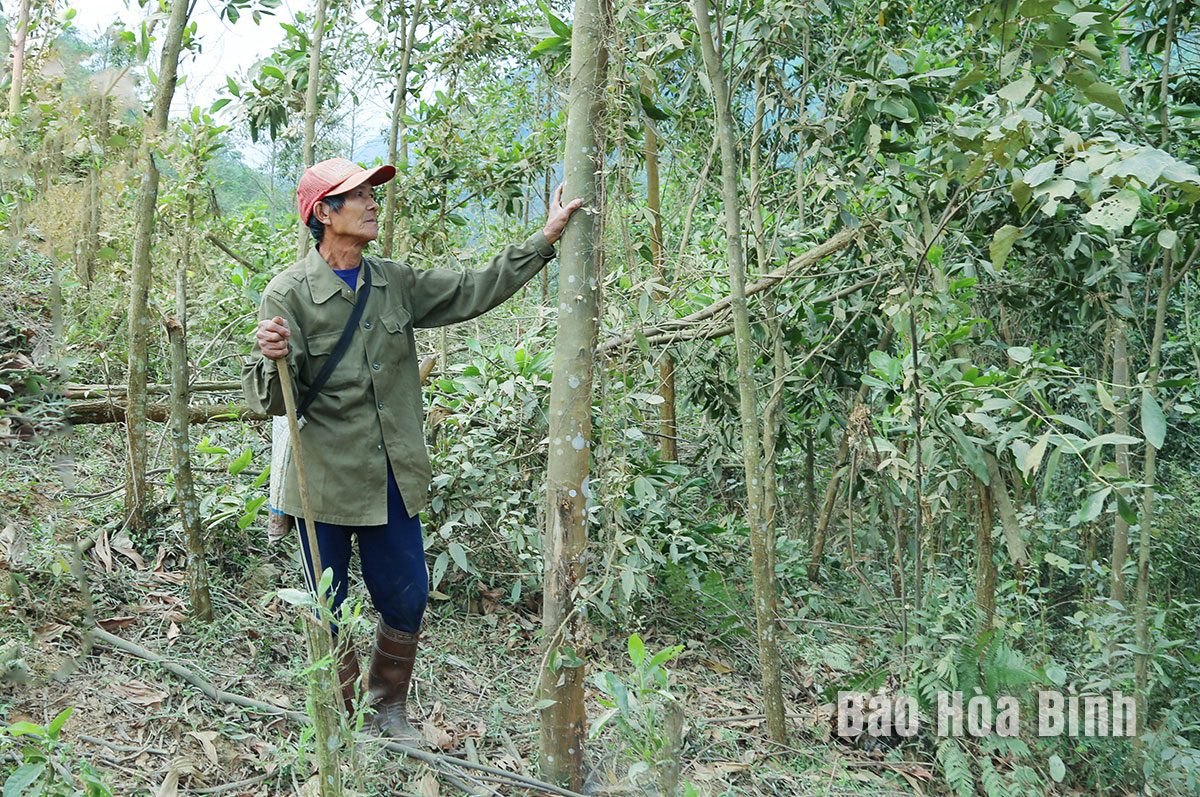
With its vast forest land, Da Bac district has focused on reforestation and developing forest economy over the past few years to improve livelihoods and increase income for local residents.
People in Rang village, Cao Son commune have got better
incomes through forest planting.
Cao Son is one of the communes that has seen significant growth in its forest
economy, with nearly 2,530 ha of forest, including over 1,340 ha of planted
forest. In 2024, the commune harvested 84.6 ha of production forest that had
reached the harvesting cycle, generating a total revenue of 10.7 billion VND
(420,000 USD) from forestry activities.
Vice Chairman of the Cao Son People's Committee Ban Van Xuan
said that local residents are further engaged in forest economic development.
As a result, the harvesting of young timber has decreased, with many households
waiting until their trees are 6 to 7 years old for better economic value.
Recently, responding to the commune’s tree planting festival, the commune
successfully plante 9,360 trees. It is expected to plant 78 ha of forest in
2025.
In the commune’s Rang village, forestry planting is the primary source of
income for residents, with over 200 ha of production forest.
Luong Van Hau, head of the village, noted that 2024 marks a
significant harvesting period for villagers, with more than 40 ha ready for
harvest. With a planting cycle of 6 to 7 years, each hectare of planted trees
yields an income of 75 to 80 million VND. After harvesting, villagers promptly
clear the land to replant for a new cycle, focusing on species such as acacia,
bodhi, and eucalyptus.
Reforestation is not only for timber but also serves as
pastureland for livestock, Hau said.
Tan Minh commune is also thriving in production forest planting.
Chairman of the commune People's Committee Quach Cong Khang said that due to
Typhoon Yagi in 2024, over 200 ha of forest in the commune were damaged, and
growers had to harvest young timber in many areas. After the Lunar New Year
celebration, residents focused on replanting these areas.
The commune targeted to plant 100 ha of forest in 2025 but so
far this year, it has planted 245 ha already, mostly acacia and bodhi species.
Additionally, the commune is surveying to pilot
cinnamon planting in several villages. The local authorities encourage
residents to grow larger timber species to enhance economic efficiency in the
coming time while utilising forested hills for compatible livestock farming.
According to the Department of Agriculture and Environment of Da Bac district,
the district plans to plant over 34,000 saplings of various types. With its
advantages, Da Bac identified that developing the forest economy is crucial for
increasing people' incomes. Therefore, the district has directed efforts to
strengthen forest protection, establish new production forests and protection,
gradually transforming small timber forests into large timber production areas
to improve forest quality and productivity.
According to data from the Hoa Binh Provincial Party Committee, the industrial production index for the first six months of 2025 is estimated to have increased by 20% compared to the same period last year. This marks the highest year-on-year growth rate for this period since 2020.
In the first six months of 2025, Hoa Binh province’s export turnover was estimated at 1.145 billion USD, marking an 18.11% increase compared to the same period in 2024. Import turnover was estimated at $ 804 million, a 17.15% increase, which helped the province maintain a positive trade balance.
The lives of the ethnic minority farmers in Tan Lac district have gradually improved thanks to the new directions in agricultural production. This is a testament to the collective strength fostered through the professional associations and groups implemented by various levels of the district’s Farmers’ Union.
With the motto the "product quality comes first,” after nearly one year of establishment and operation, Muong village’s Clean Food Agricultural and Commercial Cooperative, located in Cau Hamlet, Hung Son Commune (Kim Boi district), has launched reputable, high-quality agricultural products to the market that are well-received by consumers. The products such as Muong village’s pork sausage, salt-cured chicken, and salt-cured pork hocks have gradually carved out a place in the market and they are on the path to obtaining the OCOP certification.
In the past, the phrase "bumper harvest, rock-bottom prices" was a familiar refrain for Vietnamese farmers engaged in fragmented, small-scale agriculture. But today, a new spirit is emerging across rural areas of Hoa Binh province - one of collaboration, organisation, and collective economic models that provide a stable foundation for production.
Maintaining growing area codes and packing facility codes in accordance with regulations is a mandatory requirement for agricultural products to be eligible for export. Recently, the Department of Agriculture and Environment of Hoa Binh province has intensified technical supervision of designated farming areas and packing facilities to safeguard the "green passport" that enables its products to access international markets.



